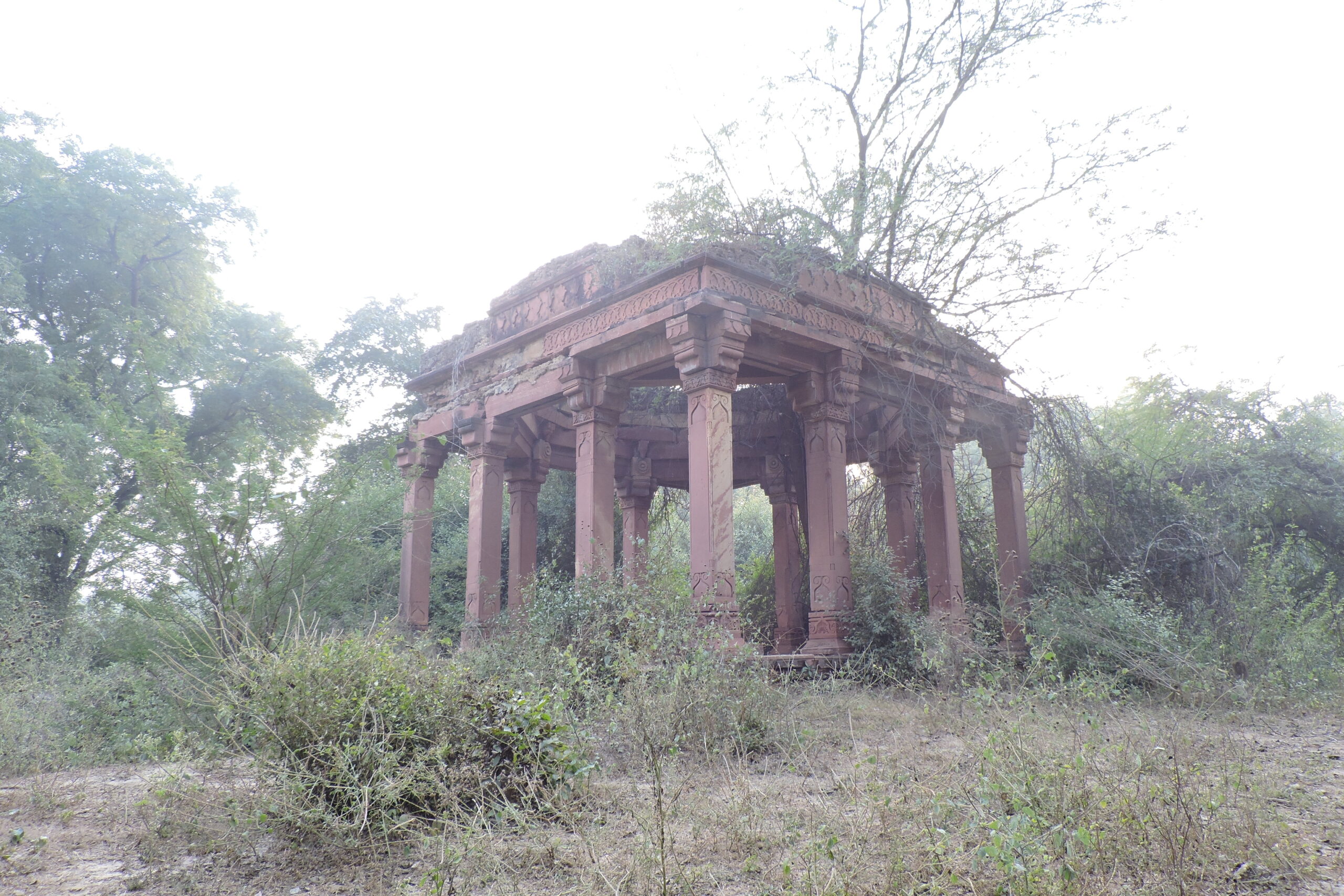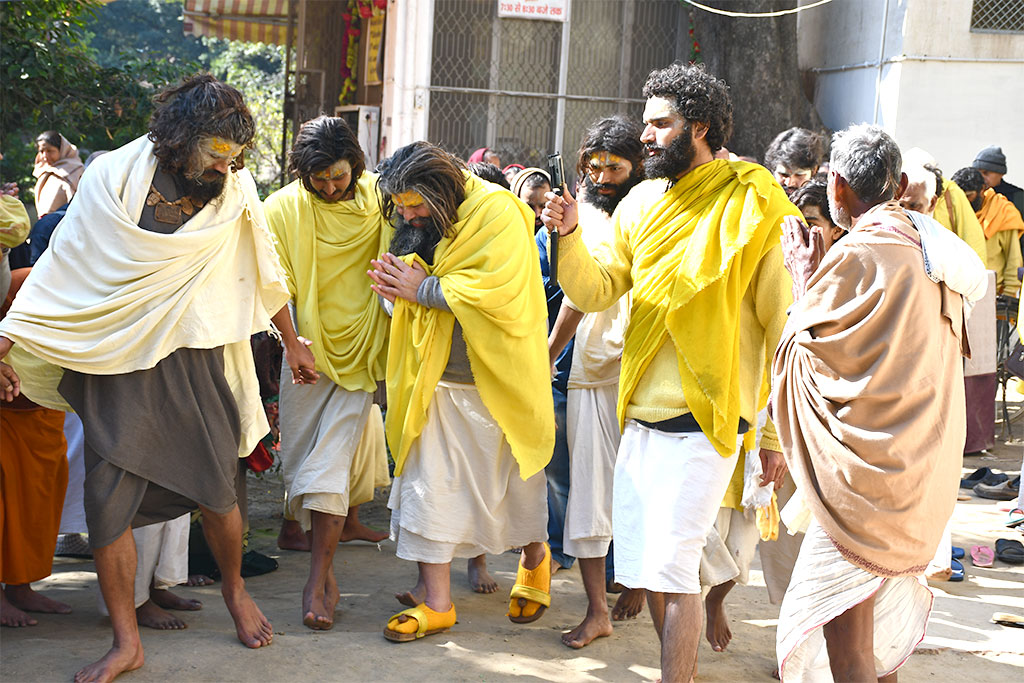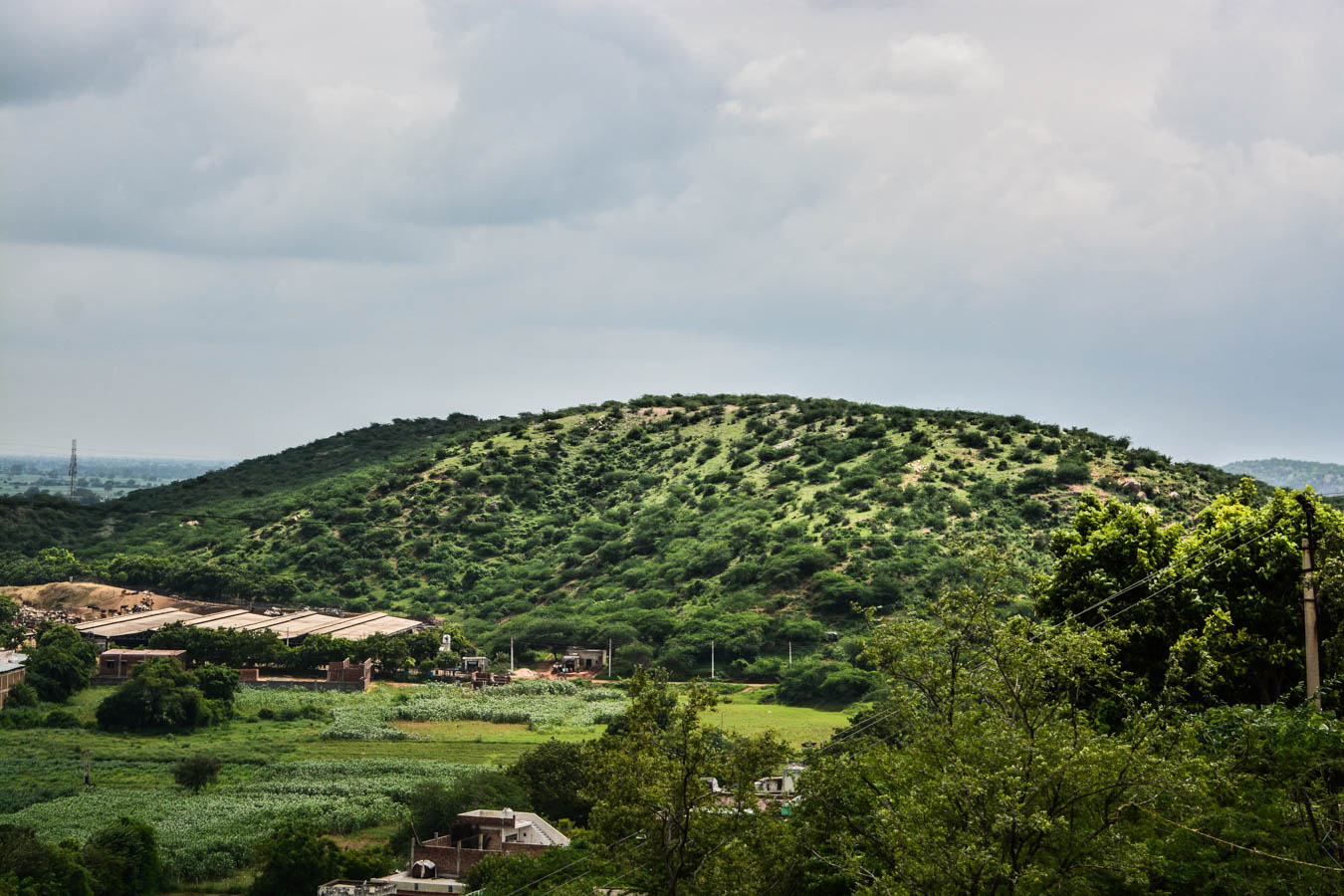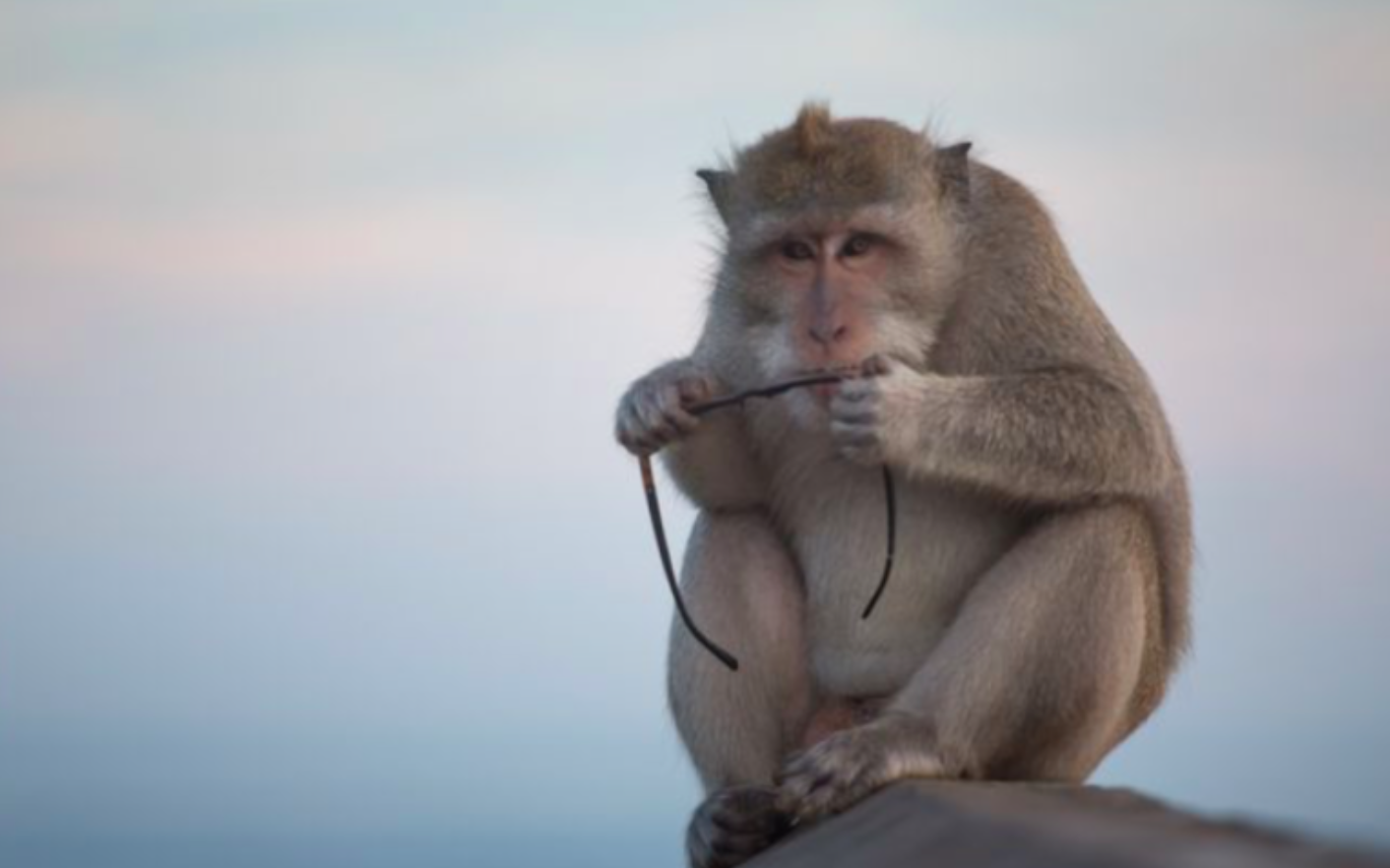If the thought of visiting Taj bibi’s samadhi crosses one’s mind when in Braj, it is more likely to be out of curiosity to find if and where does it exist, rather than about going to well-known place in remembrance of her. Overpowered by the explorer’s instinct, Vrindavan Today team
ventured out to locate Taj’s Samadhi on a cloudy winter afternoon in January.
Nearly two km away from Ramanreti (Gokul-Mahavan) a sign board read ‘Raskhan Samadhi’. Strangely, there was no mention of Taj Bibi’s mausoleum. Even the locals seemed as unaware and apathetic about it, as the State Archaeology which takes care of the nearby Raskhan Samadhi and is ostensibly responsible for Taj’s as well. Forgotten indeed is the ‘Mughal Mirabai’ (as she is known) in both life and death!
On arriving in Gokul, just near the deer park in front of Karshni Udasin Ashram, we turned left down an unpaved path through the agricultural lands. For quite some distance from there, we walked through thorny bushes and fields of wheat and mustard to reach the structure. After traversing the path overgrown with a few old trees and a lot of weed acacias (babla), we finally arrived at our destination, ‘Taj Bibi ki Chhatri’. The square construction has
twelve pillars in red sandstone. It looked like it was once crowned by a cupola. The building is neglected and an acacia tree has been growing right through that empty space for decades at least.
The structure stood deserted and dilapidated amidst a copse of trees like a ‘kunj’ surrounding it. Much like the memorial plaque that once stood at the site, Taj’s memories would also have been erased if not for the Pushtimarg/Vallabh Sampradaya that has kept them alive. So who was Taj? What was her relation with Krishna and the Pushtimarg Sampradya?
The legend of Taj
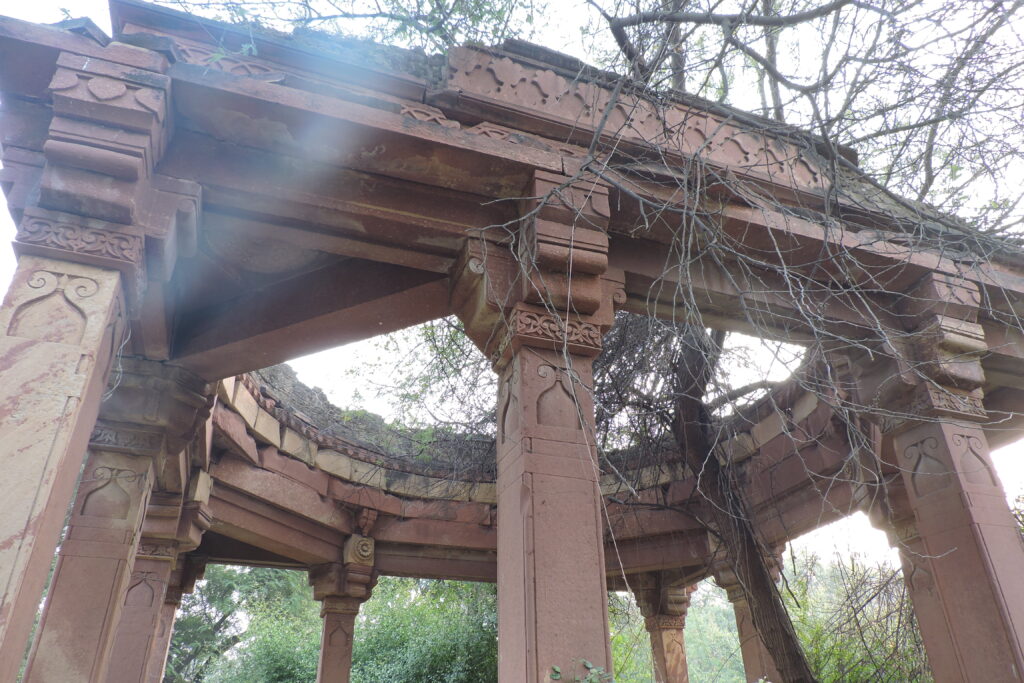
According to the legend, Taj Bibi once asked the ‘mullas’ and ‘maulvis’, “kya Allah ka didaar ho sakta hai’ (is it possible to see Allah)? She was assured that she could see Him if she went to Mecca on the Haj, even though everyone tried to discourage her saying she wastoo young. The journey to Mecca is for those in the last part of life she was told. But nothing could stop her from her desire to see God.
On the way, her party was passing through Braj and there Taj heard the ringing of the temple bells and inquired into their meaning. The Diwan travelling with the party told her that they were ringing out for the “small/lesser God” meaning Krishna. The “big” God was in Mecca.
Taj went into the temple to have a look, but being a Muslim she was refused entry. She sat in the doorway and began to sing. She then had Darshan of Krishna, which so completely changed her that she decided not to continue her journey but to remain there. Taj became the disciple of Vitthalnathji, the son of Ballabhacharya, and spent the rest of her days in Gokul.
Taj bibi: The Mughal Mirabai
According to historical records, Taj Bibi was born in Fatehpuri’s (of Shekhavati, Rajasthan) Kayamkhani Nawab lineage to the seventh Nawab, Fadan Khan, sometime in the per between 1600 and 1650 AD. The Kayamkhani Muslims of Fatehpuri and Jhunjhunu were converted Hindu Kshatriyas.
Shri Garchand Nahata, in his self-published book ‘bibi-baandi ka jhagda’ writes that impressed by Taj’s beauty, the Mughal King Akbar married her. The most important work on Kayamkhani history, ‘Kayamkhan Raso’ also states that Fadan Khan’s daughter was married to Akbar, however it doesn’t mention the name.
फदन खाँ यौ कह्यौ छत्रपति अकबर साह।
हमसे तुम नातो करहु पूजे मन की चाह।।
अकबर को बेटी दई फदन खाँ चौहान।
बढ्यो प्यार बहु प्यार में अति सुख उपजे प्रान।।
These, and the belief held by many historians that Akbar was also inspired by Shri Krishna Bhakti, attest Taj’s marriage with him. The mughal king’s meeting with his court musician Tansen’s guru Swami Haridasji is well recorded. He also issued gold and silver coins honouring Bhagwan Shri Ram and Devi Sita. He is said to have been a patron of Vallabh Sampradaya and Krishna and Rama devotees.
As per the gazetteer (Mathura) Akbar met the Goswamis of Vrindavan in the year 1672. This is corroborated in Goswami Gokulnath’s ‘Bhaav Sindhu’ which states that influenced by Vitthalnathji’s righteousness Akbar made Him the honorary judge (nyayadhikari) for Braj.
The mughal king also had a portrait of Him in his palace. It was this picture that inspired Taj Bibi to accept Vitthalnathji as guru and dedicate her life
to Krishna Bhakti.
The story goes that mesmerized by the picture, Taj coaxed Birbal’s daughter Sobhvati to write a letter to Vitthalnathji requesting him for a mantra to ensnare the King, so that he would grant her the permission to tread the path of Krishna Bhakti under the tutelage of Vitthalnathji. In reply, gosainji sent her the following ‘doha’ (couplet)
कामिन टोना, टोटका, ये बस डारो धोय।
पिया कहै सो कीजिए, आपुहि तैं बस होय।
On learning about this incident, the king’s other wives complained to him regarding Taj’s errant behavior. However, after reading Vitthalnathji’s reply Akbar was filled with such reverence for Him that he acquiesced to Taj’s wish without any resistance. It was after gosainji’s Gokul nivas somewhere around the year (Vikarm Samvat) 1628 as per the Hindu calendar that Taj Bibi took Vaishnava Diksha from him. Her intense longing for Krishna had already placed her on a higher pedestal as compared to neophytes on the path.
The following verse gives a peek into her elevated spiritual status and unalloyed devotion.
एरे दिलजानी म्हारे दिल की कहानी,
तुब दस्त हूँ बिकानी बदनामी हूँ सहूँगी मैं।
देव पूजा ठानी औ नावाज हूँ भुलानी,
तजे कमला कुरान थारे गुन ना गहूँगी मैं।।
साँवला सलोना सिरराज सिर कुल्ले दिये,
तेरे नेह दाग में निदाघ ह़ो, कहूँगी मैं।
नंद के फरजंद कुर्बान थारी सूरत पै,
हूँ तो मुगलानी हिन्दुआँनी हो रहूँगी मैं।।
Taj Bibi worshipped Krishna in the mood of separation and intense longing for reunion. It is believed that after receiving Diksha, she was blessed with darshan of Shri Govardhan Nath. One day while doing ‘sadhana’, she felt a deep pain of separation tormenting her being. Giving up food and sleep, Taj soon lost the notion of her body. It was the auspicious day of Holi, when in a state of trance she had a vision of Shri Krishna immersed in ‘Holi-Kreeda’
with His ‘parrikar’ (family and friends). She came back to senses, enlightened about her beloved’s real nature, His essence.
Her composition describing this incident became famous as ‘saadhe barah dhamaar’, and is still sung by the followers of Vallabh Sampradaya.
बहुरी डफ बाजन लोग हेली।
खेलत मोहन साँवरों हो केहि मिस देखन जाय।।
सास ननद बैरिन भई अब कीजै कौन उपाय।
ओजत गागर डारिये जमुना जल के काज।।
यह मिस बाहिर निकस के हम जाय मिलें तजि लाज।
आओं बछरा में लिये बनकों देहि बिहार।।
वे दैहे हम ही पठै हम रहेगी घरी द्वै चार।
हा हा री हौ जात हो, मो पै नाहिन परत रह्यी।।
तू तो सोचत ही रही तै मान्यो न मेरो कह्यी।
राग रंग गहगड मच्यौ नंदराय दरबार।।
गाय खेल हंस लीजिये, फाग बडी त्यौहार।
तिनमें मोहन अति बने, नाचत सबै गुवाल।।
बाजै बहु विधि बाजहिं संग मुरज डफ ताल।
मुरली मुकुट बिराजही कटि-पट बांधे पीत।।
नृत्यत आवत ताथ के प्रभु गावत होरी गीत।
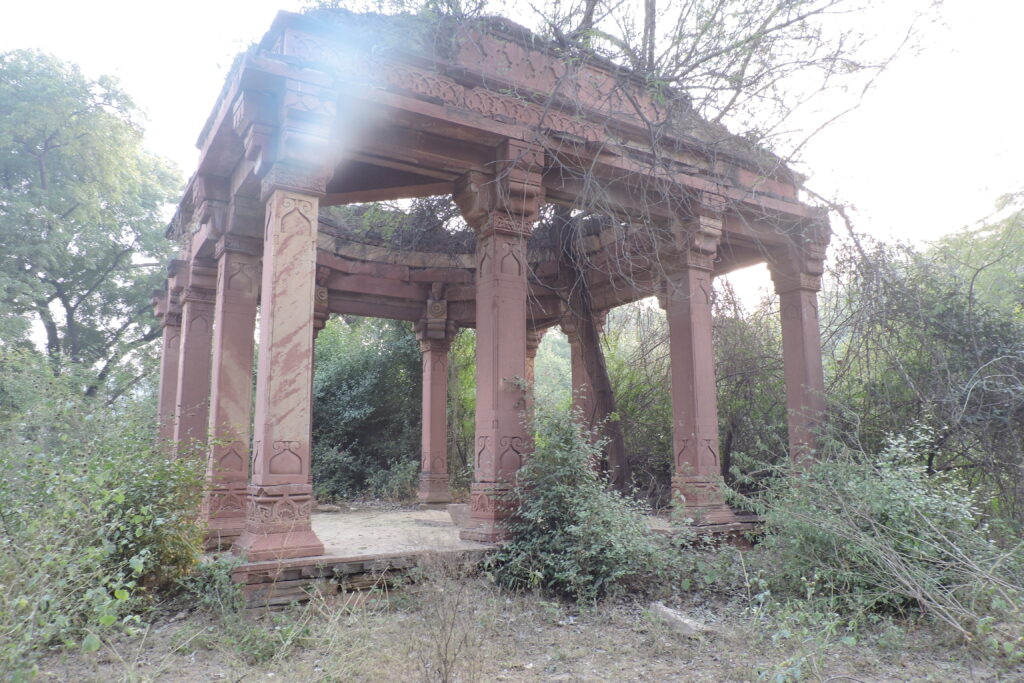
There are many other verses by Taj Bibi that were composed following similar divine experiences and visions. They bespeak her exalted status as a devotee and poet-saint. The one below describes her intense yearning for Shrinathji’s darshan.
प्रीतम बसे पहाड पै, मैं जमुना के तीर।
अब की मिलनों कठिन है, पाँइन परी जंजीर।।
अगर आगरे में रहूँ, गिरि पै बसत जु नाथ।
तोरि जँजीरन जोम सों, मैं प्रीतम के साथ।।
Taj was so attached to Braj-Gokul that she commissioned a settlement named ‘Gokulpura’ in Agra where she lived. It is a living memorial of her even today. For a Vaishnava, the end of journey in this material world is merging with the supreme object of devotion, Parabrahma Shri Krishna. Drowned in the bliss of her beloved’s vision, Taj Bibi lost all bodily sense one day. She ran to catch her beloved who was engaged in playing Holi. The maidservants tried to stop her only to realise later that Taj had left, and what lay in their lap was merely her mortal self. Her ‘makbara’ (tomb) was erected in Gokul’s Ramanreti, the place she was most attached to.
Taj Bibi is among the most revered saints of Pushtimarg Sampradaya. Sihor resident, Shri Govind Gilla Bhai has given a list of her works in his book. These include ‘Ganesh Stuti’,
‘Saraswati Samaradhana’, ‘Dashavatar Varnan’, ‘Bhavani Vandana’, ‘Nirodh Kavita’, ‘Hori-
Phaag’, ‘Baramasa’, and other short compositions.
We leave the readers with a couple of them…
छैल जो छबीला सब संग में रंगीला,
बडा चित्त क अडीला सब देवतों में न्यारा है।
माल गले सोहै नाक मोती सेत जोहै कान,
कुंडल मन मोहै लाला मुकुट सिर धारा है।।
दुष्ट जन मारे सब सन्तन उबार ‘ताज’,
चित्त हितवारे प्रेम प्रीतिकर धारा है।
नन्द जू को प्यारा जिन कंस को पछारा,
वह वृन्दावनवारा कृष्ण साहिब हमारा है।।
काहु को भरोसो वेद चारहू जो पढै़ होत,
काहु को भरोसो गंगा न्हाये साहस चार को।
काहु को भरोसो सब देखन को पूजे ‘ताज’,
काहु को भरोसो विधि शंकर उदार को।।
काहु को भरोसो मनि पाये मिले पारस को,
काहु को भरोसो सूर-वीदन के लार को।
तारन तरन कृष्ण सुने जो जहान बीच,
मौको तो भरोसो एक नन्द के कुमार को।।


